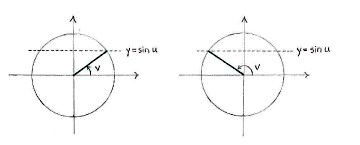Lösung 4.4:5a
Aus Online Mathematik Brückenkurs 1
K |
K (Robot: Automated text replacement (-{{Displayed math +{{Abgesetzte Formel)) |
||
| Zeile 1: | Zeile 1: | ||
If we consider for a moment the equality | If we consider for a moment the equality | ||
| - | {{ | + | {{Abgesetzte Formel||<math>\sin u = \sin v</math>|(*)}} |
where ''u'' has a fixed value, there are usually two angles ''v'' in the unit circle which ensure that the equality holds, | where ''u'' has a fixed value, there are usually two angles ''v'' in the unit circle which ensure that the equality holds, | ||
| - | {{ | + | {{Abgesetzte Formel||<math>v=u\qquad\text{and}\qquad v=\pi-u\,\textrm{.}</math>}} |
[[Image:4_4_5_a.gif||center]] | [[Image:4_4_5_a.gif||center]] | ||
| Zeile 13: | Zeile 13: | ||
We obtain all the angles ''v'' which satisfy (*) by adding multiples of <math>2\pi</math>, | We obtain all the angles ''v'' which satisfy (*) by adding multiples of <math>2\pi</math>, | ||
| - | {{ | + | {{Abgesetzte Formel||<math>v = u+2n\pi\qquad\text{and}\qquad v = \pi-u+2n\pi\,,</math>}} |
where ''n'' is an arbitrary integer. | where ''n'' is an arbitrary integer. | ||
| Zeile 19: | Zeile 19: | ||
If we now go back to our equation | If we now go back to our equation | ||
| - | {{ | + | {{Abgesetzte Formel||<math>\sin 3x = \sin x</math>}} |
the reasoning above shows that the equation is only satisfied when | the reasoning above shows that the equation is only satisfied when | ||
| - | {{ | + | {{Abgesetzte Formel||<math>3x = x+2n\pi\qquad\text{or}\qquad 3x = \pi-x+2n\pi\,\textrm{.}</math>}} |
If we make ''x'' the subject of each equation, we obtain the full solution to the equation, | If we make ''x'' the subject of each equation, we obtain the full solution to the equation, | ||
| - | {{ | + | {{Abgesetzte Formel||<math>\left\{\begin{align} |
x &= 0+n\pi\,,\\[5pt] | x &= 0+n\pi\,,\\[5pt] | ||
x &= \frac{\pi}{4}+\frac{n\pi}{2}\,\textrm{.} | x &= \frac{\pi}{4}+\frac{n\pi}{2}\,\textrm{.} | ||
\end{align}\right.</math>}} | \end{align}\right.</math>}} | ||
Version vom 08:59, 22. Okt. 2008
If we consider for a moment the equality
| \displaystyle \sin u = \sin v | (*) |
where u has a fixed value, there are usually two angles v in the unit circle which ensure that the equality holds,
| \displaystyle v=u\qquad\text{and}\qquad v=\pi-u\,\textrm{.} |
(The only exception is when \displaystyle u = \pi/2 or \displaystyle u=3\pi/2, in which case \displaystyle u and \displaystyle \pi-u correspond to the same direction and there is only one angle v which satisfies the equality.)
We obtain all the angles v which satisfy (*) by adding multiples of \displaystyle 2\pi,
| \displaystyle v = u+2n\pi\qquad\text{and}\qquad v = \pi-u+2n\pi\,, |
where n is an arbitrary integer.
If we now go back to our equation
| \displaystyle \sin 3x = \sin x |
the reasoning above shows that the equation is only satisfied when
| \displaystyle 3x = x+2n\pi\qquad\text{or}\qquad 3x = \pi-x+2n\pi\,\textrm{.} |
If we make x the subject of each equation, we obtain the full solution to the equation,
| \displaystyle \left\{\begin{align}
x &= 0+n\pi\,,\\[5pt] x &= \frac{\pi}{4}+\frac{n\pi}{2}\,\textrm{.} \end{align}\right. |

